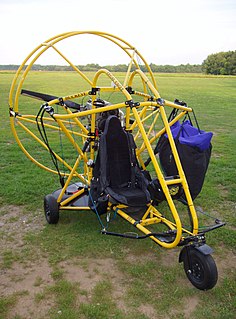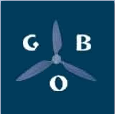| Crazy Flyer | |
|---|---|
| Role | Powered parachute |
| National origin | Germany |
| Manufacturer | Büttner Propeller |
| Status | In production (2015) |
| Unit cost | €14.543 (Crazy Flyer 2, less wing, 2004) |
The Büttner Crazy Flyer (also called the Crazy Flier) is a family of one and two-seat German powered parachutes designed and produced by Büttner Propeller of Obernkirchen. The aircraft are supplied complete and ready-to-fly, but without wings. [1]

Germany, officially the Federal Republic of Germany, is a country in Central and Western Europe, lying between the Baltic and North Seas to the north, and the Alps to the south. It borders Denmark to the north, Poland and the Czech Republic to the east, Austria and Switzerland to the south, France to the southwest, and Luxembourg, Belgium and the Netherlands to the west.

A powered parachute, often abbreviated PPC, and also called a motorised parachute or paraplane, is a type of aircraft that consists of a parachute with a motor and wheels. The aircraft's airspeed is typically about 25–35 mph (40–60 km/h). PPCs operate safely at heights ranging from a few feet off the ground to altitudes as high as 10,000+ ft (5.5 km), but typical operating heights are between 500 and 1500 feet above ground level (AGL). Equipped with a standard 5 or 10 gallon fuel tank, PPCs can typically be flown for about three hours before requiring refueling. They have very short take-off and landing rolls, sometimes less than 100 ft. PPCs are among the least expensive aerial vehicles. A new one-person powered parachute may cost as little as $10,000, though double-seaters more typically cost about $20,000. Top end two-seater PPCs usually cost $25,000–$35,000. Empty weight is typically around 200–300 lb (90–135 kg) and payload can be upwards of 500 lb (225 kg). In the United States, many of the smallest single-seat PPCs are flown under 14 C.F.R. § 103 of the Federal Aviation Regulations, which allows them to be flown without a license or flight instruction. Flight instruction is, however, highly recommended, and an average student can learn to fly a PPC safely with 5 to 10 hours of flight instruction. Two-seat PPCs are light sport aircraft in the United States. The pilot must have at least a sport pilot certificate issued by the FAA to fly them. A minimum of 12 hours of flight instruction, including 2 hours of solo as a student pilot, is required to obtain this certificate. Powered parachuting is not to be confused with powered paragliding.

Büttner Propeller, also known as Gerald Büttner - Obernkirchen, is a German aircraft manufacturer based in Obernkirchen and founded by Gerald Büttner. The company specializes in the design and manufacture of powered parachutes, paramotors and aircraft propellers. The aircraft are ready-to-fly designs for the European Fédération Aéronautique Internationale microlight and 120 kg categories.






